One of the first questions I always get when people outside of the public art world find out that SVV and I run a nonprofit devoted to community improvement through paint is inevitably this: “How do you find your artists?” And while we find them so many different ways—through our travels, through social media, through our website intake form, through word-of-mouth referrals—if you work in public art or aspire to, there are several things you can proactively do to get more work as a muralist.
Introduce yourself
The easiest way to get on our or any mural program’s radar? Reach out and say hi! Even if we don’t have a wall or funding or project that’s a fit right this very moment, that doesn’t mean something won’t arise in the future. We keep a very meticulous database of muralists, their location, and their specialty or medium that we reference any time a new project pops up.
“Sometimes people are sitting back and waiting for us to invite them,” our friend Kris Kanaly, founder of Plaza Walls, agrees. “The people who reach out and tenaciously say, ‘how can I get involved?’ are the ones who are going to get on our radar.”
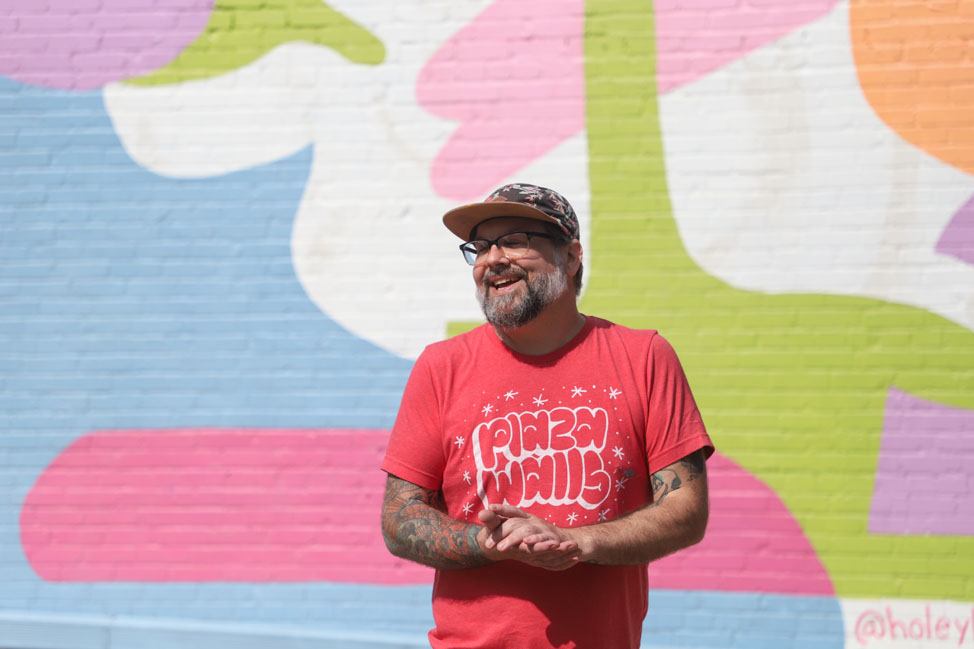
Kris Kanaly in front of the Holey Kids’ piece in OKC’s Plaza District
Of the 17 muralists we have commissioned work from in the past year, 35 percent of projects hired were those who had reached out to us first, 53 percent were artists we reached out to because we’d seen their art, and 12 percent were artists we’d worked with before and had such a great experience we hired them back.
And there are many artists who we’ve passed along to cities, business owners and other nonprofits when a good fit arose. All that to say that us, the collective art curators and nonprofit organizations, even knowing you exist is the first step.
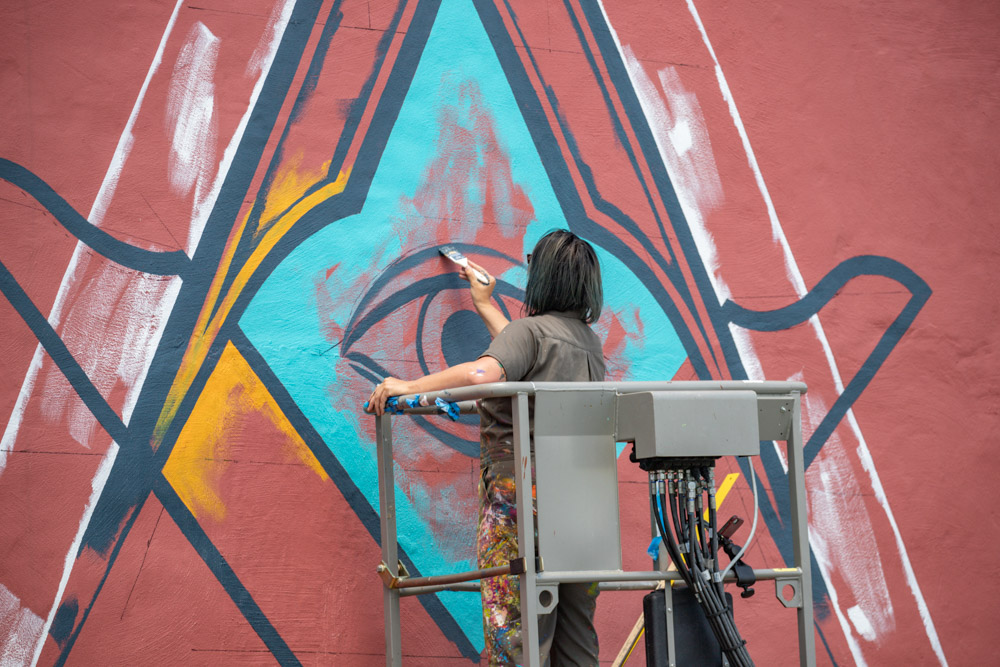
Kim Radford, the most gracious artist to work with, painting the Masonic Lodge in Tullahoma. We met Kim because she reached out to us via our website!
Be easy to find
I find a lot of new-to-me artists, where else, but on Instagram. And the ones I’m most likely to reach out to are those who have an easy way to contact them by email on their Instagram page or professional site. While initial introductions over Instagram are totally fine, I don’t like conducting business via Instagram DMs, so if you’re wanting to up your professional game as a muralist, you’ll have a contact button on your profile, as well as an email address on your website, so you can easily be reached outside of social media.
I was in a Clubhouse for mural festival organizers a few months ago, and one fellow curator echos my feelings on the issue: “I don’t have time to hunt you down and cyber-stalk you. [Artists] miss that opportunity for themselves unfortunately.”
Also, LIST YOUR LOCATION. I am so tired of artists saying “will travel for work” without letting me know where they’re based. This is an automatic deterrent. We bring in many of our artists from other states, but you’re wasting my time and yours by not putting your home location in your profile.
Build out your site portfolio
One of our favorite artists, Mobe, has a very clean website in which almost all of his public art work is featured and of which he keeps his project page regularly updated. This is great for me, a curator, as I can pull an easy example for a client or city who may want to bring him in to paint.
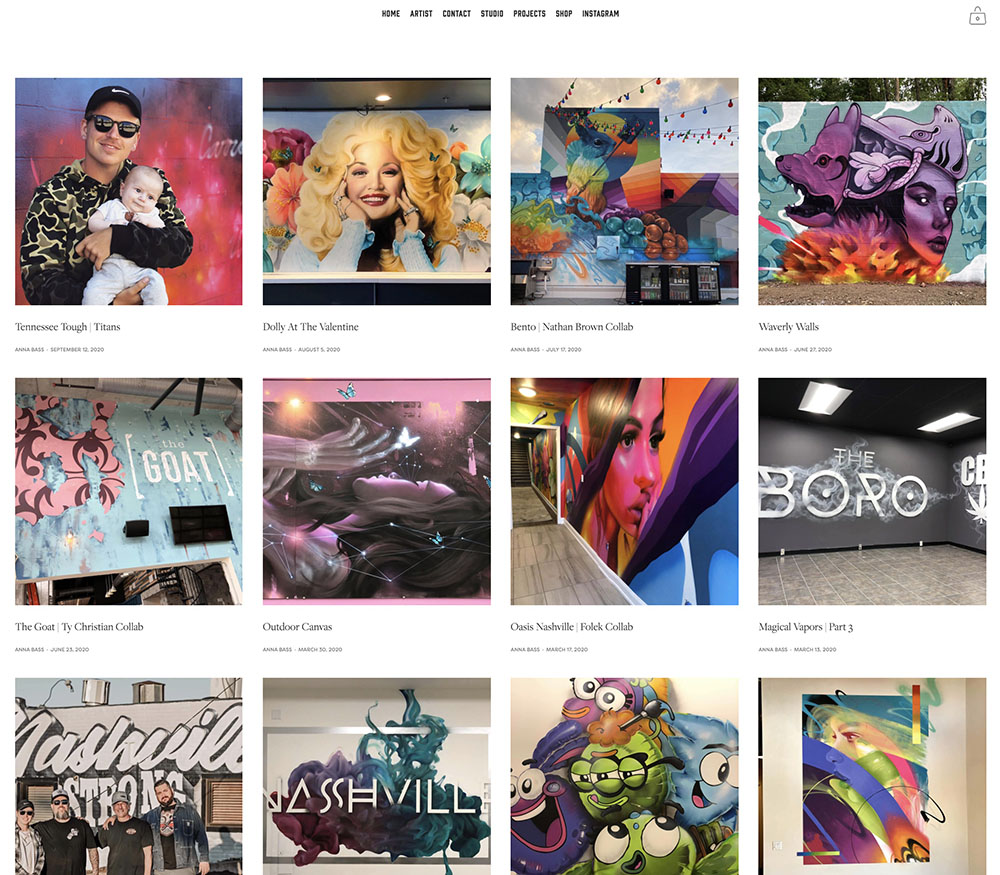
Make sure your site is secure, though—that SSL certificate is clutch, and so many businesses still pop up a security warning—as well as mobile friendly. You want to come across as the professional small business you are after all.
Just this weekend, in fact, I met an artist at a craft festival I not only wanted to purchase from, but reach out to about potentially working with us in the future. Only when I went to her site listed in her social media profiles, it was blocked for not being secure—on both search engines and Instagram. She not only lost on on a guaranteed sale but also potential mural work in the future (I did email her to let her know her site wasn’t secure but your average person isn’t going to take the time or have the patience).
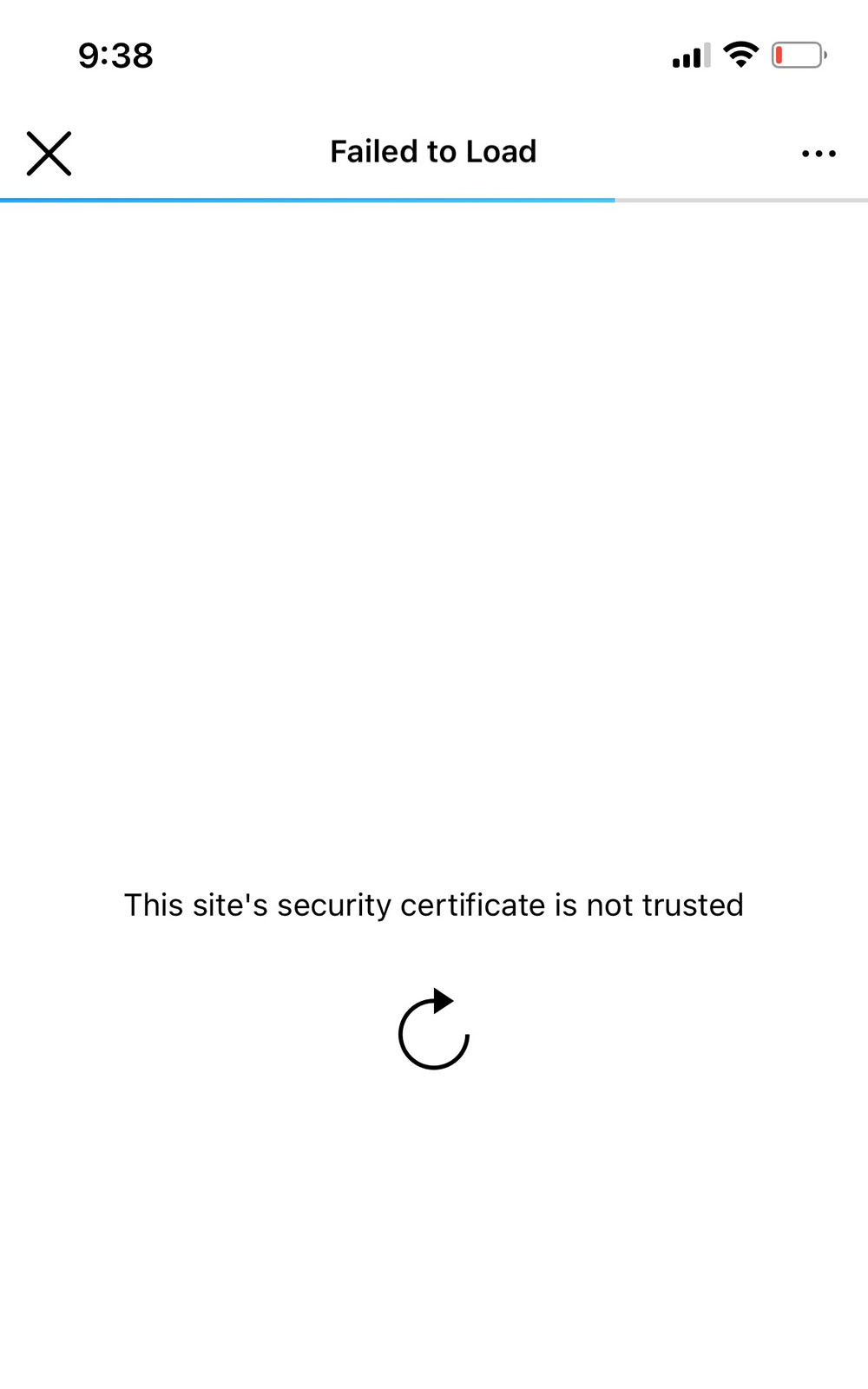
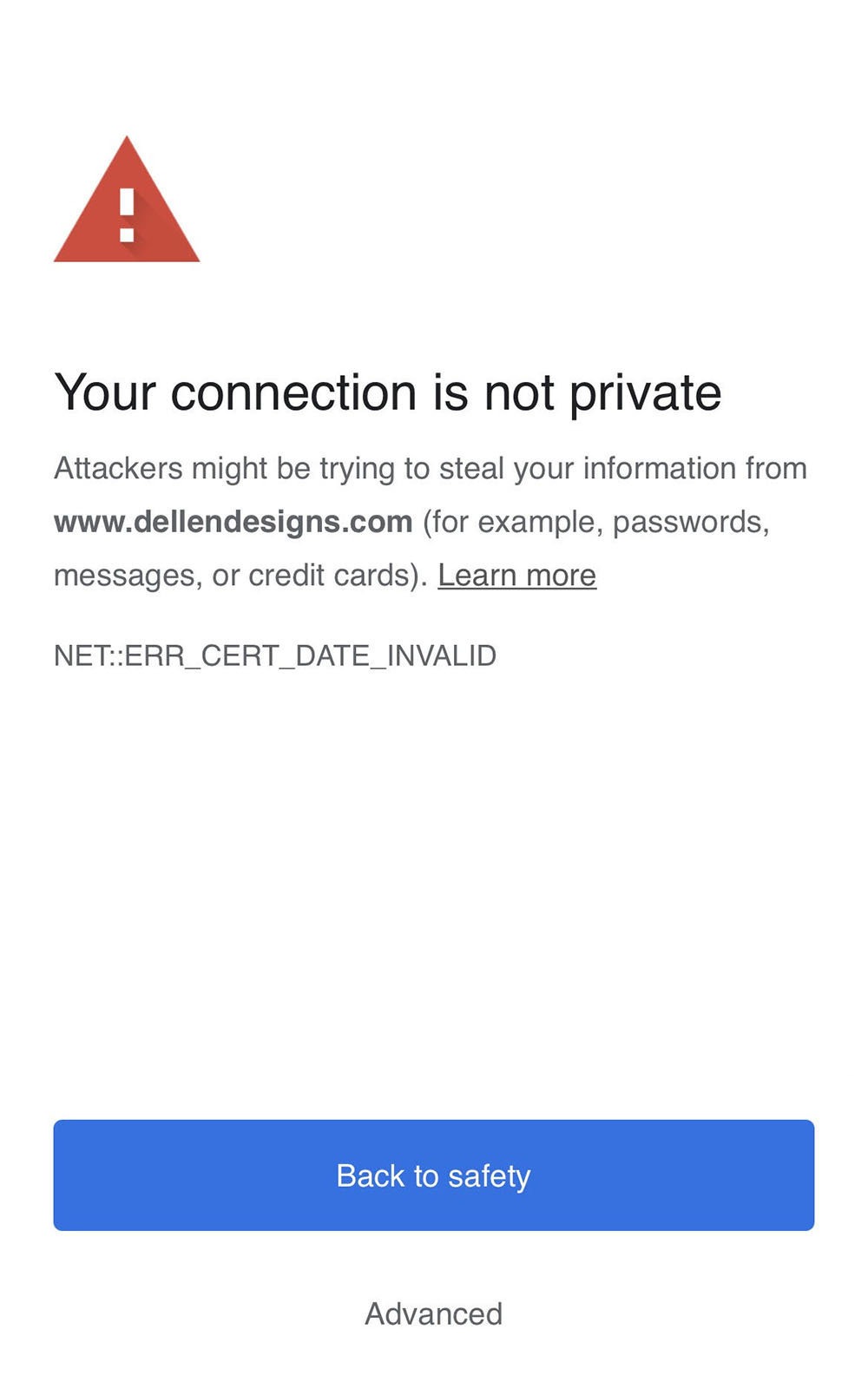
Keep your portfolio up to date
What’s hard as a curator is when I know in my heart that an artist is skilled, but his/her Instagram, Facebook or website don’t show off completed works or how multifaceted that artist is and, therefore, the building owner or patron I’m pitching simply has to take a leap of faith (and 30+ murals in, that’s really hard for us as a nonprofit to sell to a sponsor or building owner). If you’re an artist, please, please, please post a clear photo of every completed mural in between your WIPs and BTS post.
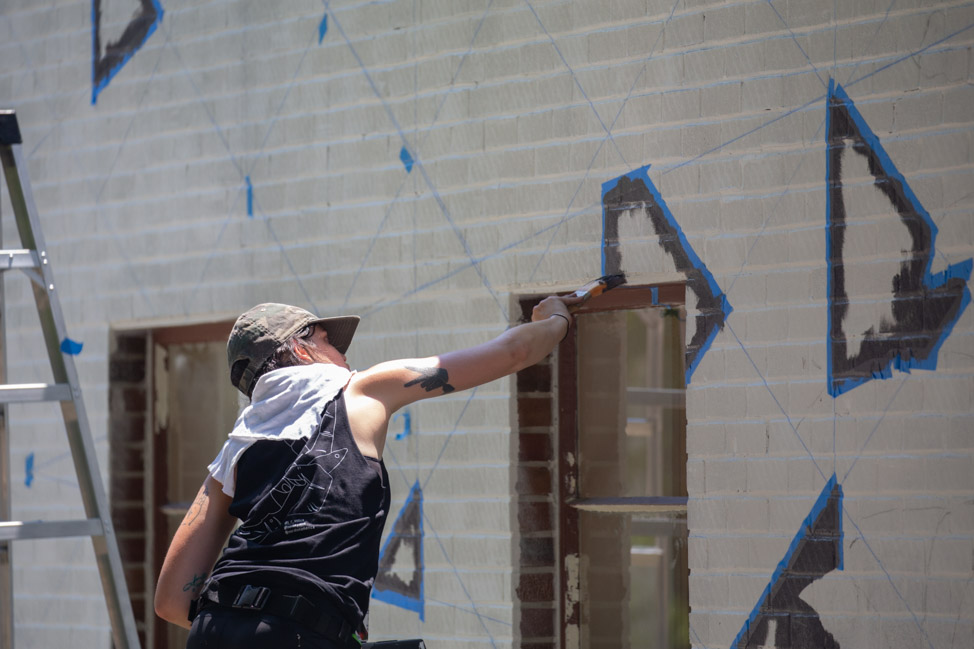
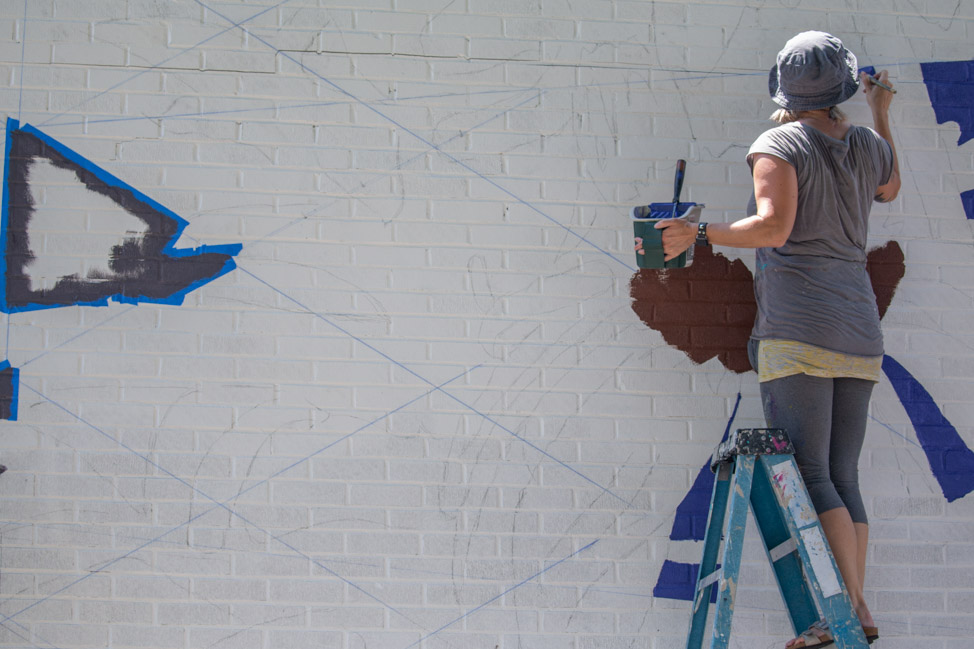
Two of the best in the industry, Atalie Gagnet and Jenny Ustick, painting in McMinnville.
Similarly, keep your social media profiles, primarily Facebook and Instagram, up to date with full finished shots of your most recent projects. WIPs are great for engaging your audience; completed projects are even better for inking your next job.
Furthermore, if you do have a contact form on your site (great!), also have your email listed somewhere. Typically, when I’m doing a cold outreach out for a project, I want to send images of the wall along with it to cut down on back-and-forth, and contact forms do not allow for attachments. Contact forms also can be a turn-off for some, so it’s best to have both options available.
Don’t be a diva
This applies to any field, but we see it a lot in some muralists who have been sponsored by a big name and suddenly think they’re worthy of Brad Pitt paychecks. And maybe they are—who am I to say?—but in our area in the rural South, for a small nonprofit, a Mercedes-level budget simply not realistic.
I thought the pandemic might humble people in general, but it seems to have had the opposite effect. I’ve encountered artists who have done little to no large-scale public art seem to want the sun, the moon and the stars by way of compensation, and sorry but social media stardom is not a barometer for how much a piece of art is worth.
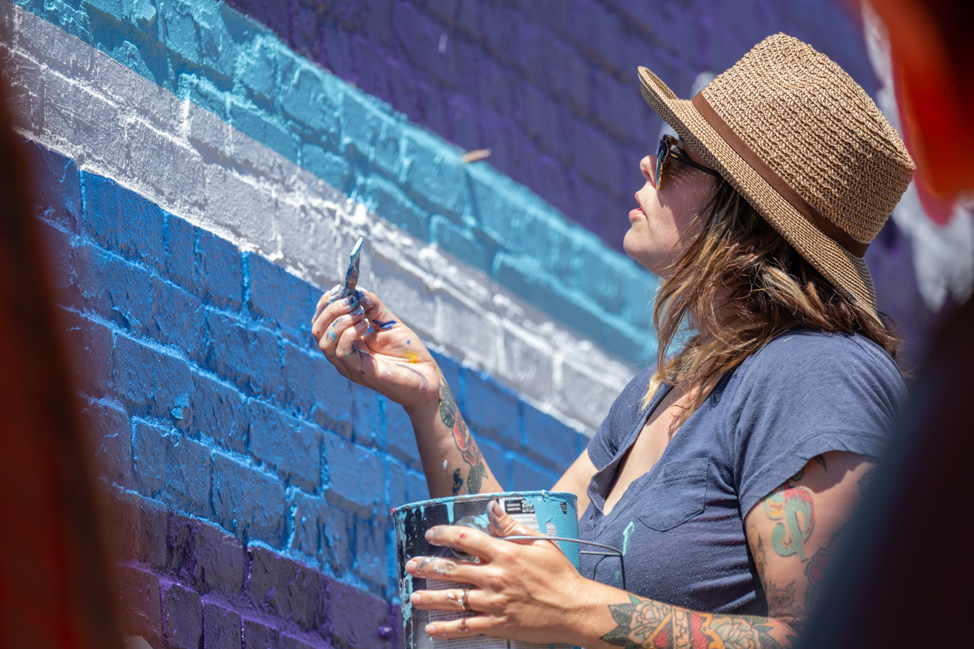
Not-a-diva Whitney Herrington, one of my favorite artists to work with!
Just like in any creative arts field—mine as a writer and photographer included—your art is worth what people are willing to pay for it. So if I have, say, a budget that includes a $4,000 artist fee and you tell me “but Chicken-Fried Angel Wings paid me $12,000 to paint a pair of wings on its building,” I don’t care. That’s great that Chicken-Fried Angel Wings has a healthy budget, as corporations should since there’s a far greater PITA fee when a big brand is involved, but I’m telling you what I, the president of a small nonprofit, can afford within the budget I’ve been given, which is so often dictated by grant funding and a lot of red tape. You are free to accept or decline (and if the latter, I will not be offended because we all have different needs and priorities).
What won’t get you far? Giving attitude.
Know the market and how to price your work
Many muralists will try to quote a square footage model, and that simply doesn’t work for us or the majority of nonprofit mural curators we know. Why? Because, well, every artist’s style is different to start. I watched one artist, Tara Aversa, spend six days using a one-inch brush to paint the American flag magnolia while other spray paint artists might tackle the same space in a day. I’ve always appreciated Tara quoting a project fee or daily rate (with a cap) as opposed to square footage.
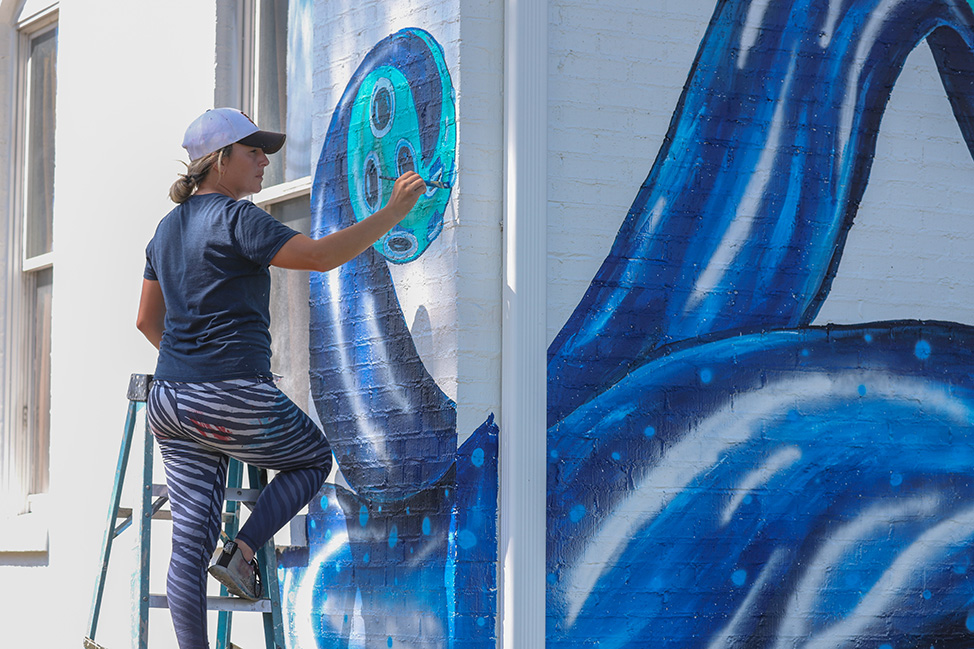
Tara Aversa, Nashville muralist, painting Bertha the octopus in Tullahoma.
On the contrary, when most artists quotes me a square footage price—versus a project fee based on complexity of design or time involved—I simply roll my eyes and think they’ve unfortunately got their hands on a pricing guide distributed by a duo largely considered the MLMs of the mural world. The reason this doesn’t work for most nonprofits as much of our funding comes from grants, meaning we have a cap on what we can spend—and it’s very set with little wiggle room.
Also when we receive these grants, we don’t always know what building we’ll be painting. As evidenced by several of our projects where we’ve had as many as five walls fall through—whether due to historic zoning commission ignorance, the building owner getting cold feet, the target property selling or a non-historic building somehow falling into a designated category—with funding set, so we don’t just have an extra $10,000 laying around to cover some arbitrary square-footage fee. There’s a lot behind the scenes that others never know goes into how much a project can run.
So how do you price your work? In my opinion, by an estimated time a project requires. Think of the traditional work model, which starts with an hourly rate that’s used as the basis for a salary. That’s how internally I price out all writing, editing, photography or marketing projects that I take on—come up with how much I want to make that project and break it down to a daily rate based on my time estimate—and I can adjust that rate based on complexity of the project and how many levels of approval it takes.
If you as a muralist have a wall that might take you four days, think about what your time is worth; this will depend largely on your skill level and how long you’ve been in the industry. Let’s throw out a random number of $350 a day as an example and say you work an average eight-hour day; that works out to $44 an hour, which is not a bad daily rate. If a mural takes you five days at that rate, which is $1750, plus you tack on another two days for the conceptual work at the beginning, you get to $2100.
But if you look at the proposed model logically and all your expenses (lift, lodging, materials) are covered, i.e. not included in that paycheck (as they should never be), then $2,100 is not a bad starting wage for a week’s work. If you worked 50 weeks a year and took the standard U.S. two weeks of vacation, that still puts you at a six-figure salary.
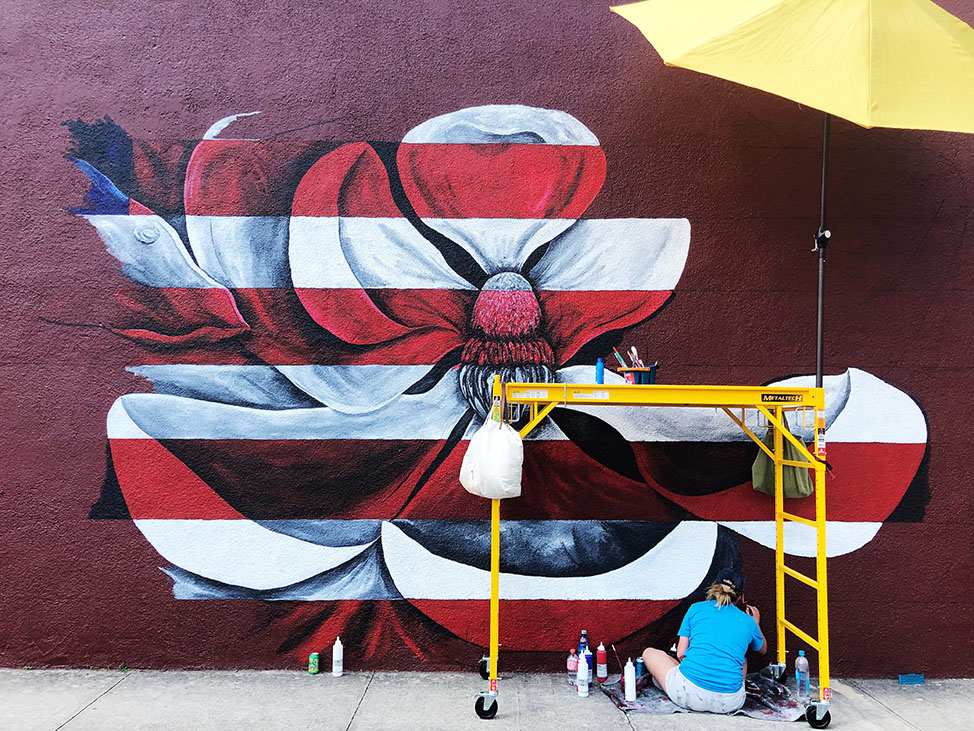
Tara painting the (in)famous Southern magnolia in Manchester.
Now, I’m not telling you what is or is not average in the world of public art because to be completely honest there is no “average” cost of a mural; it ranges depending on location, surface painted, wall size, complexity of design, whether there are committees involved or not—you get the gist. And there are definitely examples of when a big muralist is working with a huge corporate sponsor with an unlimited budget when a square-footage model may benefit the artist; I’m simply telling you what works and what doesn’t work for nonprofits and small-town street art.
On our end, as a nonprofit, we take the overall budget and break it down into buckets: cost of base paint, cost of prep work, cost of lift or scaffolding, cost of lodging and/or transportation, cost of artist materials, then we know what we have to pay an artist. Material, equipment and travel costs alone can quickly add up to more than $7,000.
Once we have figured the above, we approach who we think is a good fit for that particular wall with the artist fee we are offering and tell them they are free to use as much space as they feel is fair for the compensation. We never, ever say they must use the whole wall, and if our budget doesn’t work for a muralist, then we completely understand if they have to decline. It’s nothing personal, simply a business decision.
What quickly lands a muralist on our blacklist is the incessant need to negotiate, argue a price or ask how we came up with a budget even when we’ve told them the price is firm and there’s no wiggle room. Our budget is our budget—we have a baseline for what all mural projects cost and hope to increase that over the years, but for now it is what it is—and we don’t have to justify it to anyone. Materials and equipment suck up a lot of the budget, not to mention there is so much red tape when you factor in state and federal grants, plus city governments, that artists never see.
Be communicative (i.e. quick to respond)
As in any industry, a response within 24 hours is ideal, a response within 48 hours is considered courteous. Anything else shows you don’t really care all that much (even if that isn’t true).
Even if the email is simply to say: “I’ve received your message and am interested in the proposal. However, I’m on site painting all week and will have to get back to you this weekend,” that’s fine! But to go seven days or longer without so much as a response? Your curator or mural festival organizer has likely moved on to the next artist on his/her list.
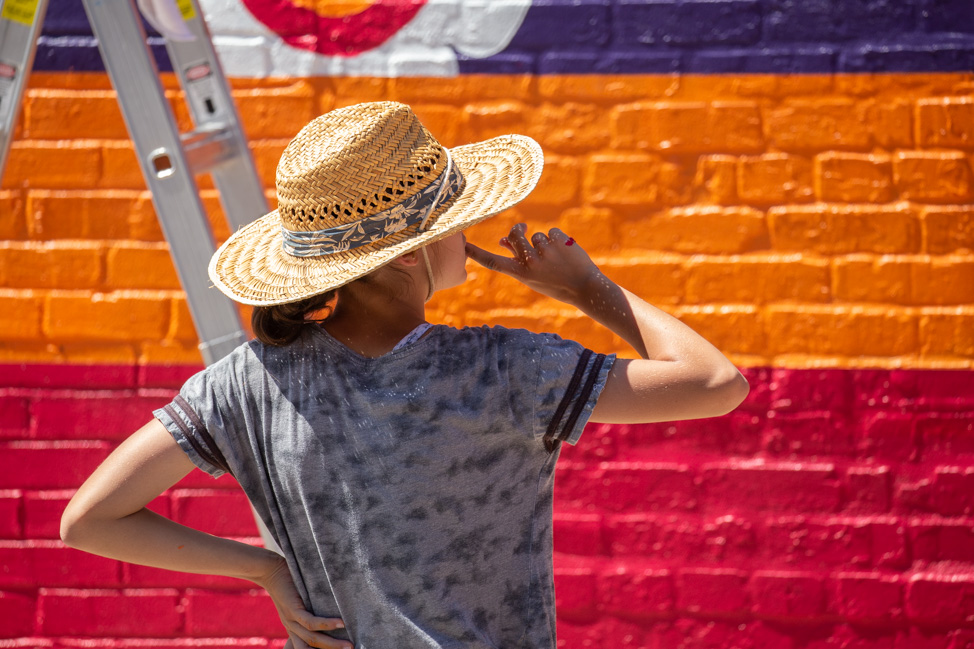
The kiss of death for so many creatives—be it in the mural world, media circles, influencer industry, whatever—is a lack of communication or timeliness. If you can’t respond to a simple email offering you a job, the professional who wants to hire you likely sees that as a sign upfront you’re not going to meet other deadlines and, thus, is likely going to move on to the next muralist who does know how to operate a small business effectively.
Have some festivals on your radar; be wary of others
While mural festivals don’t traditionally pay that great—many only cover travel (if that) and a small stipend (if that)—the right ones can be an excellent way to network with other muralists and curators alike; networking that leads to paying gigs down the road. Sure, there are some that don’t have great reputations for how they treat artists, but others like Plaza Walls’ Mural Expo, Cincinnati’s BLINK and Sacramento’s Wide Open Walls that could be a good opportunity for the right artist.
One muralist, JUURI, we have worked with and adore maintains a running spreadsheet of mural festivals and other painting programs she’d like to be a part of. Mural festival organizers are always looking for new talent. So you missed the deadline for this year’s big festival? Go ahead and introduce yourself to the parties that be now so that they know of you a year from now when they’re recruiting talent for the next event.
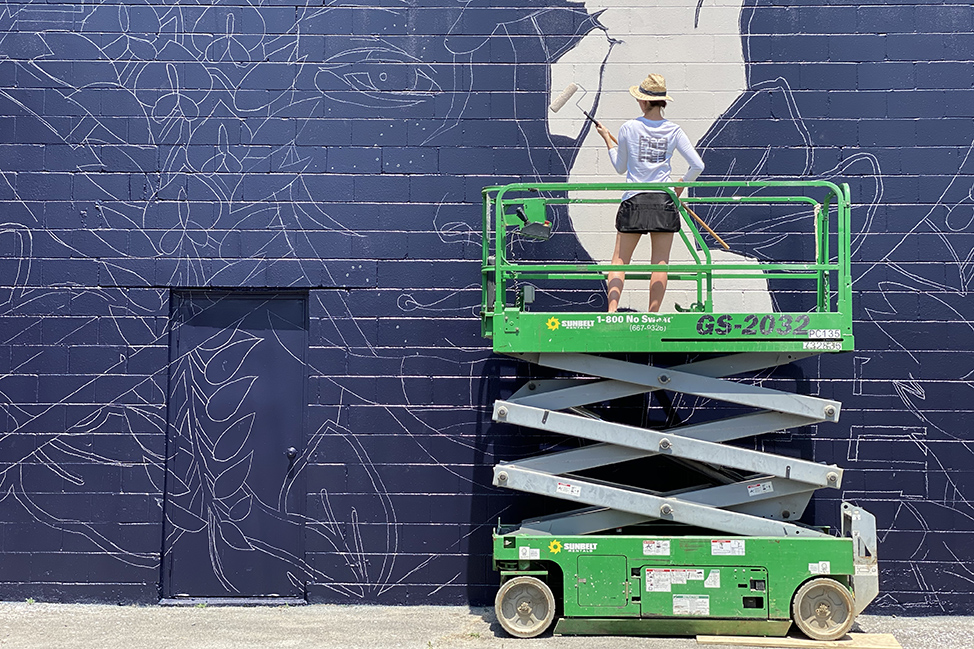
Like in any industry, a lot of mural gigs come about through word of mouth, so the more fellow muralists you befriend, the more likely you are to have your name passed along to other programs. Do this long enough, and eventually the hope is that the work and connections will be a domino effect.
Plus, artists can be flaky—sorry, y’all, but you know it’s true—and often back out last minute. If you’re flexible and willing, being on a backup list is another way to get in the door.
Any questions? If you’re a muralist looking for more work and have questions, feel free to leave them in the comment section below—or drop us a line if you’re interested in painting in Tennessee down the road.
PIN IT! SAVE THIS POST FOR LATER
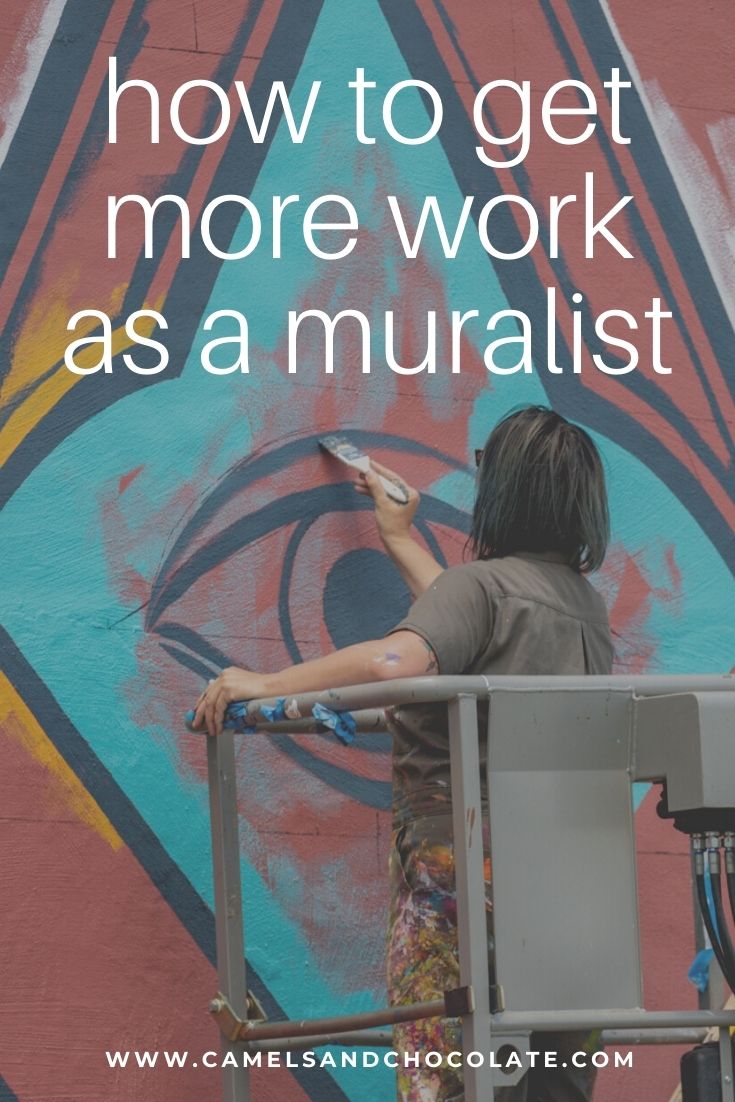
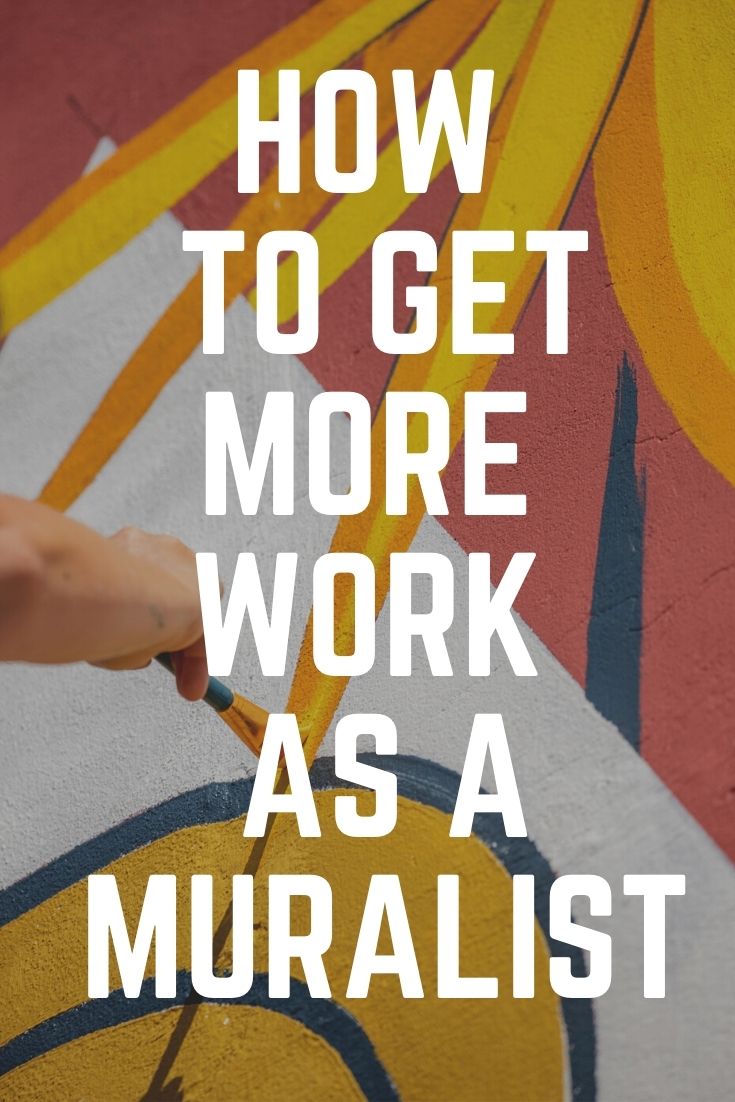
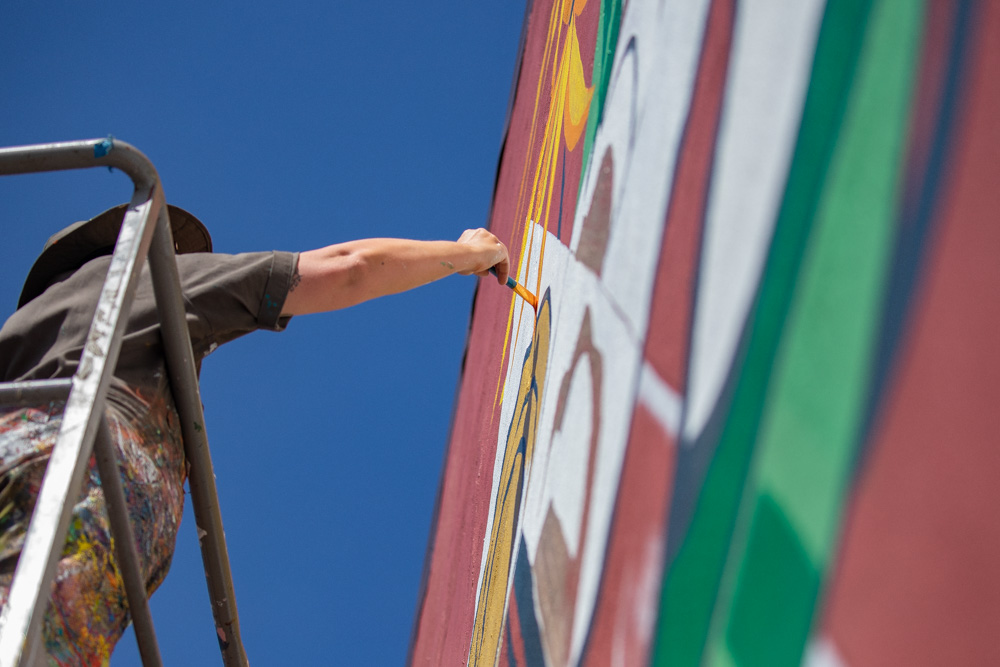
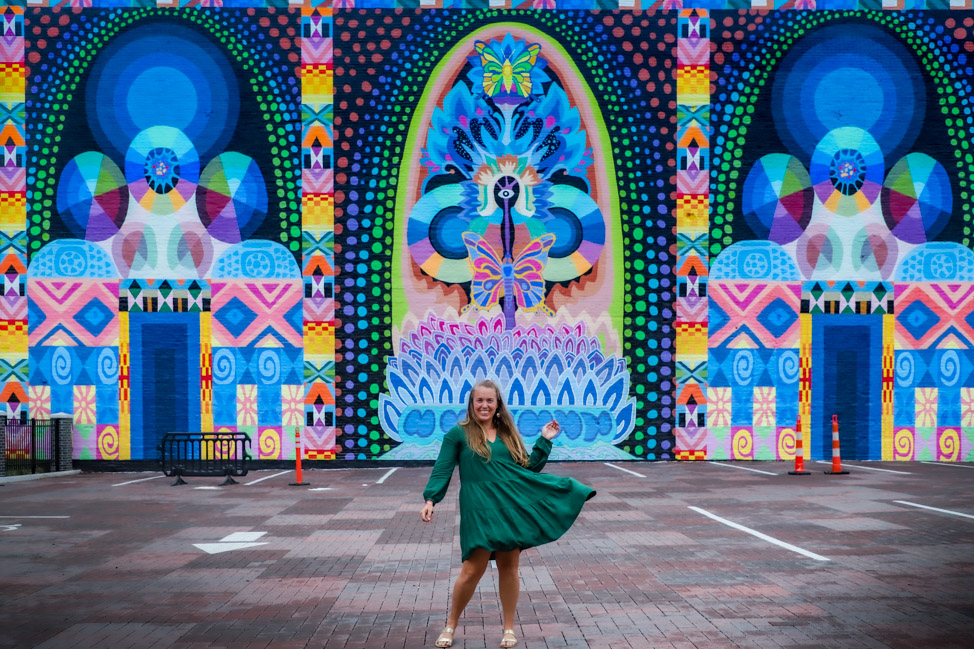

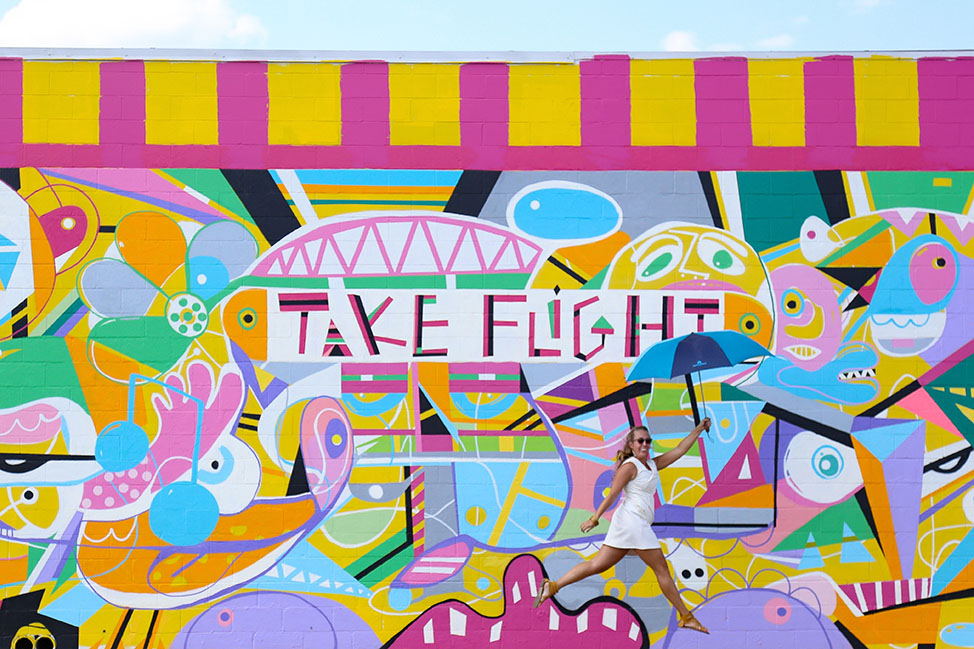
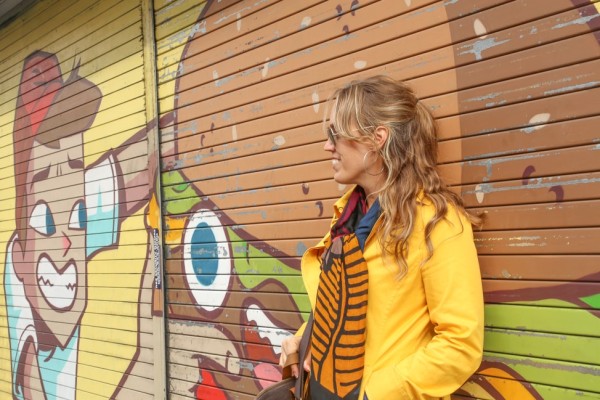










Hi Kristin,
I found your article informative. I am a muralist/artist from the metro Detroit area, specifically Waterford, MI. I have been self-employed for over 20 yrs., have a BFA in art, and have done just about everything under the sun, large murals, smaller murals in residential, churches, schools, businesses, small things like borders, faux finishes, imitation marble, portraits, stenciling, painting on furniture, just about anything over the years. I recently started putting together a website. Up until recently, I only had a flickr account: http://www.flickr.com/photos/joescolart/albums. I have been operating on word of mouth for years. It’s hard to join the tech world. I prefer living in the 1970s-1980s.
In my experience, I think what customers have appreciated about me is I am very flexible and easygoing, work within their budget, try to fulfill their vision, charge by the project based on time and complexity ( not by square foot which you pointed out) , I work quickly and do not take breaks, I am not there to waste anyone’s time or be in the way, I efficiently get it done so they can move on to other things, I would lay in bed thinking about the painting all night if I let the completion of it linger for days. I don’t understand how prima donna artists even get exorbitant amounts or lack flexibility. I once replaced an artist painting murals in a cigar bar because he refused to do what the owner wanted. If I am commissioned for a project, I do what the person paying me wants. If I want to make my own art at home, I do it any way I desire. But for a client, you do what they want. Advise ways something looks the best or adjust it according to their taste. Many times I have changed a mural to satisfy a client and thought it looked better before I changed it. I am aware I am doing something according to their desire.
Be efficient, be flexible, be extremely low maintenance, and everything goes smoothly. Michelangelo and Masaccio walked around day and night in their work clothes. A large part of being an artist is being a workman/skilled tradesman (with a gift, and in some cases enlightened mind and spirit).
I hope everything is well with you.
Thanks,
Joe
Hey Kristin, my name is Riffie and I’ve been drawing since childhood and started painting in my 30’s. I have painted several murals but can’t seem to get a good start with getting clients. I would love to be considered to working with you on doing a mural. I have a Facebook page with some of my work and you can find that under Murals by Riffie or I can email you some pictures of my work. Let me know if you’re interested in seeing them.
Thanks, Riffie
Hi! Great article I appreciate the helpful info. I’m a muralist, I spent a few years working for a free Mural painting companies before starting my own in 2018 “float boater murals”. My experience has made me rather versatile, able to do any which style. Of course my own style is always preferred, which tends to be a beautify chaotic abstract style with hints of graffiti art, with a lot of flow and usually including a bit of tranquil stillness within the perplexity, done with geometric shapes or some use of clean sharp lines. Anyways I’ve got plenty of experience and I’m always looking for more work. I’m based in Los Angeles but I’ve done work all over Cali and surrounding states as far as Colorado. Check out my Instagram @damnit_gabe or just Google me (DamnitGabe or my business float boater murals to see my work! Thanks
Hello,
I when to school for art and design but never made a career out of it. I recently transitioned from a completely different field back into the arts. After my son was diagnosed with autism and I went through a divorce I decided to go back to what I love most in life which is creating meaningful art. I am slowly building a following on TikTok with 15k followers. I would love to get into murals and start making a more Stable income in this field. If you have any opportunities for new muralists I would love an opportunity and would be willing to travel anywhere to get my work out. Feel free to email me or call. 347-993-1333
I greatly appreciate any opportunities big or small to start.
Thank you,
Angela
Hi! I was just updating my website and doing some research about mural work (because I have had a hard time putting myself out there so far) and stumbled across this page. Very informative and helpful. I am living in Portland, Oregon but I am originally from Tennessee and have tons of friends there so I would DEFINITELY be open to traveling for a mural project. This year I am really focusing on putting myself out there more so I will try to do this in as many ways as I can. Thanks for your article about this and I hope to hear from you in the future.
Jessica
Im a traveling muralist who would LOVE some more work. I’ve been constantly busy for the past 4 years until this year. I need to keep my motivation and inspiration flowing but the slow business is killing me.